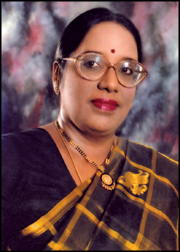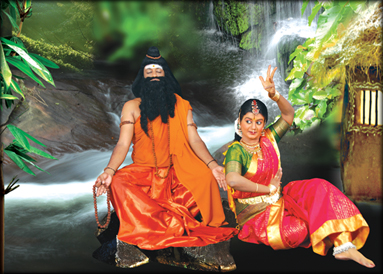Review
Abhijnana Sakuntalam:
An enchanting odyssey into Kalidasa’s Sakuntala
By Ranga CHANDRARATHNE
 |
|
Director Deshanethru
Kalasuri Arunthathy Sri Ranganathan |
Marked for its remarkable blend of traditions, Sakuntalam, Kalidasa’s
masterpiece presented by Indian Cultural Centre in Colombo and produced
and directed by Aru Sri Arts Theatre is, perhaps, one of the best
productions to come from contemporary Sri Lankan theatre. A musical
dance drama, though sans dialogues, was able not only to convey the
story in vividly realised choreographed acts performed but also through
the masterly trained cast who gave life to the characters from the
Sanskrit classic.
One of the significant aspects of the musical dance drama was the
sheer blend flavours from diverse traditions of dancing such as
Kathakali, Kathak, Oddissi, Kuchupudi and Kalari, though the production
was fundamentally in Bharathanatyam style. Apart from blending two main
stream Indian classical music traditions, dance traditions, lyrics in
Sinhala blended well with the accompanying music scores.
The dance drama commenced with a scene where the sage Vishwamitra was
in a deep meditation. However, the king of the god Indra sent Menaka, an
Apsara (nuptial) to distract the sage from the deep meditation. Menaka
succeeded in seducing Vishwamitra leading to the birth of Sakuntala.
Eventually Vishwamitra distanced from Menaka and the child. Menaka left
the child in the forest. According to the story, the child was protected
by birds.
Meanwhile, Kanva Rishi found the child and took her into his Ashram
known as ‘Kanva Ashram’, which was on the banks of the Malini River.
The king Dushyanta, on a hunting expedition with his army, met
Sakutala and fell in love with her. He gave his ring with royal insignia
as a sign of love, promising that he would return. However the story
turns a tragic as powerful Rishi Durvasa cursed her as Sakuntala failed
to greet him.
According to the curse, the person of whom Sakuntala was dreaming,
Dushyanta would forget all about her. On pleading by her friends, the
Rishi reduces the curse and that person who had forgotten Sakuntala
would regain his memory once the ring that had been given to , being
shown to him.
As time passed by, Sakuntala set out to meet her husband king
Dushyanta in the city. However, on the way, she dropped her ring into
the Ganges. At Dushyanta’s court, she was humiliated as Dushyanta failed
to recognise her.
Thus humiliated Sakuntala returned to the forest with her son Bharata.
Meanwhile, a fisherman found the ring with royal insignia in the
stomach of a big fish and caught by royal guards while he was attempting
to sell it in the market. On seeing the ring, Dushyanta regained his
memory of Sakuntala.
The story concluded with the reunion of Sakuntala with Dushyanta.
Innovative presentation
Sakuntalam musical dance drama was, among other things, marked for
its innovative presentation. It has excelled in many aspects including
in its colourful costumes which represented Hindu culture and the milieu
in which the story was set. Particularly the elaborate garments of
Dushyanta and that of Sakuntala stood out. The tribal dance of the
fishermen with colourful costumes also added allure to the performance.
It seemed that Members of Chandana Wickramasinghe’s Dancers’ Guild, who
performed the fishermen’s dance, had really captured the mannerism of
the fishermen. Another aspect which is noteworthy is that almost all the
actors who performed in the dance drama, had mastered their allotted
roles. Since diverse flavours from range of dancing traditions had been
incorporated into the musical dance drama, the choreography seemed to be
a complex exercise.
 |
|
A scene from Sakuntalam; Abhiramy
Kandeepan and Chandana Wicramasinghe |
However, Kalasuri Arunthathy Sri Ranganathan and the members of Aru
Sri Art Theatre were able to overcome the inherent limitations in
diverse traditions of dancing. Perhaps, the most difficult task would
have been to synchronise Sinhala lyrics with Carnatic music scores. It
should be mentioned here that lyrics were marvellously done by Dr.
Praneeth Abeysundara capturing the subtle nuances of scores of moods and
emotions demanded by the dance drama.
However, the fact remains that the audience may not feel the subtle
fusion of traditions as it is always a struggle between preserving
original characteristics of diverse traditions and sacrificing some of
the elements in the process of fusing them. Though at times, Sinhala
lyrics seemed not perfectly nelded with Carnatic music, it had not
disturbed the zest of the drama.
Amazingly, the director has stuck to the tradition throughout the
performance. Diverse elements and flavours from range of dancing
traditions such as Kathakali, Kathak, Odissi, Kuchupudi and Kalari, with
two mainstream Indian Classical Music traditions, have been meticulously
incorporated into the dance drama.
Impressive acting
Although Sakuntalam was marked for its impressive acting which was a
combination of diverse traditions of classical dancing and music, some
of the overplaying had been counterproductive and contributed to lessen
the principle zest of the play. For instance, over doing of roaring of
the lion was, in fact, counterproductive. Tharaka Pathmila Ovitagedara
as lion performed the role convincingly. The impressive costume of the
lion together with equally matching colour would have been sufficed to
convey the idea of a roaring lion. However, the overdoing of roaring had
drawn the music which accompanied with the lion’s performance.
Understandably the pronunciation of some Sinhala words was not clear
although it had not disturbed the performance.
The orchestra comprised traditional instruments such as Mridangam,
Violin, Flute and Tabla. The only non-traditional or out of the
tradition instrument used was Keyboard. Choreography for Sakuntalam was
entirely by the members of the Aru Sri Art Theatre; Abiramy Kandeepan,
Sakitha Kugamoorthy, Lakshmi Subramanium Sharma and Josita Peter. Music
for Sakuntalam was by Kalasuri Arunthathy Sri Ranganathan. The cast
included Lakshmi Subramanium Sharma (Sakuntala), L.R. Nidheesh Kumar
(Guest Artiste, Kalakshetra, India), Chandana Wickramasinghe (Vishwamitra)
and Abiramy Kandeepan (Menaka and Gowthamy).
|

